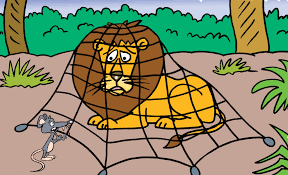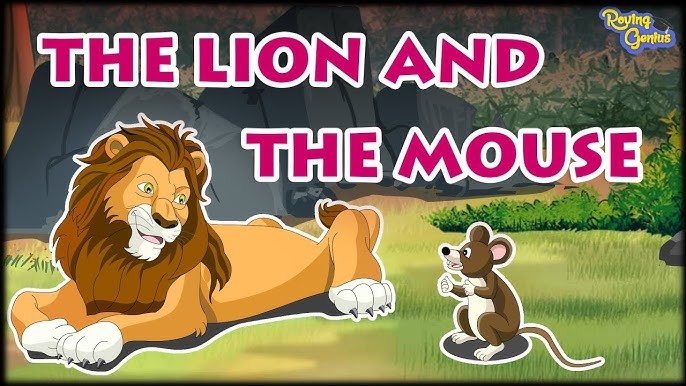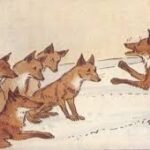One of Aesop’s most enduring fables, The Lion and the Mouse, is a deceptively simple story with profound implications about power, mercy, and the interconnectedness of all beings. The tale begins with a mighty lion, the undisputed king of the jungle, who captures a tiny mouse in his paw. The mouse, trembling in fear, pleads for his life, promising that one day he might repay the lion’s kindness. Amused by the idea that such a small creature could ever help him, the lion decides to spare the mouse out of sheer magnanimity—or perhaps pity. This moment of mercy sets the stage for the story’s dramatic reversal later when the lion, caught in a hunter’s net, finds himself helpless. The mouse, remembering the lion’s earlier act of compassion, gnaws through the ropes, freeing the mighty beast and proving that no act of kindness, no matter how small, is ever wasted.
While the fable is often told as a children’s bedtime story, its origins trace back to ancient Greece, where Aesop—a former slave turned storyteller—used animal allegories to convey moral truths. What many don’t realize is that versions of this story appear in multiple cultures, including Indian and African folklore, suggesting a universal recognition of its core message. In some variations, the trapped animal is not a lion but another powerful figure, such as an elephant or a bear, while the rescuer may be a bird or even an insect, reinforcing the idea that strength comes in many forms. The story’s adaptability across cultures speaks to its fundamental truth: true power lies not in dominance but in mutual dependence and unexpected alliances.
The characters themselves are rich in symbolism. The lion, often depicted as the epitome of strength and pride, represents unchecked authority and the illusion of self-sufficiency. His decision to spare the mouse—an act that seems insignificant at the time—reveals a fleeting moment of humility, a crack in the armor of his arrogance. The mouse, on the other hand, embodies the underestimated and overlooked members of society. His repayment of the debt is not just an act of gratitude but a quiet assertion of dignity, proving that even the smallest beings have value. The hunter’s net, a seemingly minor detail, serves as a great equalizer, reducing the lion—a creature of unmatched physical power—to helplessness, much like how life’s unforeseen challenges can humble even the mightiest individuals.
Beyond its surface-level moral about kindness, the fable carries deeper philosophical undertones. It challenges traditional hierarchies, suggesting that power is not absolute but situational—what good is a lion’s strength when bound by ropes? It also critiques pride, illustrating how the lion’s initial amusement at the mouse’s offer reflects a dismissive attitude toward those deemed “beneath” him. The story’s resolution subverts expectations, as the “weak” mouse becomes the savior, while the “strong” lion must accept help, a humbling experience that reshapes his understanding of strength. This dynamic has made the fable a favorite among educators and philosophers, who use it to discuss themes of empathy, reciprocity, and the dangers of underestimating others.

Historically, the tale was not just entertainment but a tool for moral instruction. In ancient Greece, where oral storytelling was central to education, Aesop’s fables were used to teach virtues like wisdom, justice, and moderation. The Lion and the Mouse, with its clear cause-and-effect structure, was particularly effective in demonstrating how mercy could yield unforeseen rewards. Later, during the Renaissance, the fable was often depicted in art and literature, symbolizing the idea that even rulers must practice clemency—a lesson not lost on kings and statesmen who saw themselves in the lion’s role. Jean de La Fontaine, the French fabulist, adapted the story in the 17th century, adding poetic flourishes that emphasized the mouse’s courage, further popularizing the tale in Europe.
In modern times, the fable’s relevance has only grown. Psychologists reference it when discussing the “helper’s high,” the idea that acts of kindness benefit both the giver and receiver. Environmentalists draw parallels to ecosystems, where every creature, no matter how small, plays a vital role—much like how the mouse’s action preserves the lion, a keystone species. The story has also been adapted into countless formats, from animated shorts to corporate training modules, where it serves as a metaphor for teamwork and the importance of valuing every team member’s contributions. Its enduring appeal lies in its simplicity and universality; whether applied to personal relationships, social justice, or leadership, the message remains clear: compassion is never wasted, and humility is the mark of true strength.
What makes The Lion and the Mouse particularly compelling is its lack of overt moralizing. Unlike some fables that end with a heavy-handed lesson, this one allows the events to speak for themselves. The lion does not lecture the mouse on gratitude, nor does the mouse gloat about his reversal of fortune. Instead, the story trusts the reader to recognize the inherent justice in the outcome—a subtlety that makes its wisdom more palatable and memorable. This restraint is a hallmark of Aesop’s genius, proving that the most powerful lessons are often those left unspoken.
Ultimately, the fable’s longevity can be attributed to its ability to resonate across ages and cultures. It is a story that children adore for its excitement and adults revisit for its depth, a rare narrative that grows richer with each retelling. In a world increasingly divided by power imbalances and social stratification, The Lion and the Mouse offers a quiet but radical reminder: no one is too strong to need help, and no one is too small to give it. Whether encountered in a preschool classroom or a philosophical discourse, its lesson remains timeless—kindness, no matter how small, is the thread that weaves the fabric of a just and compassionate world.
Go to main page


